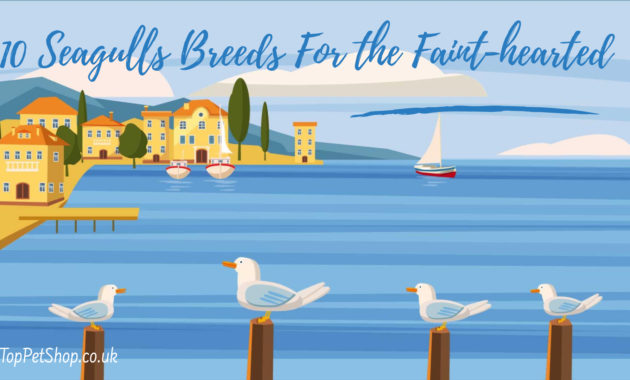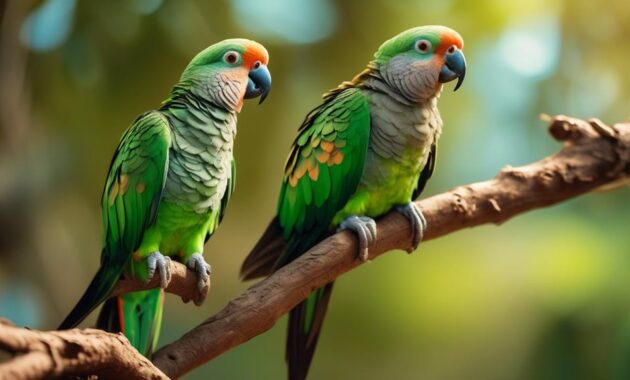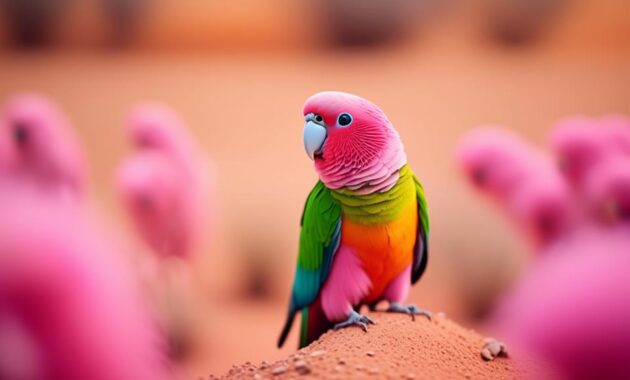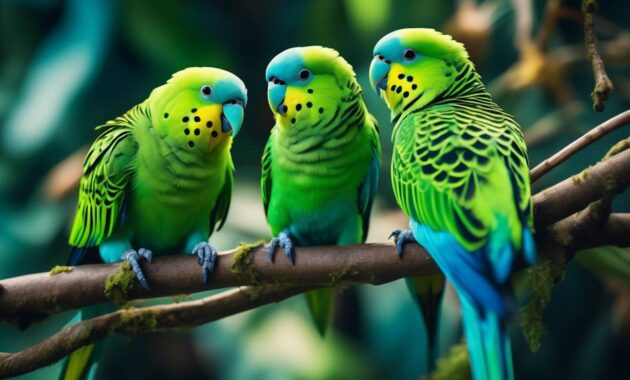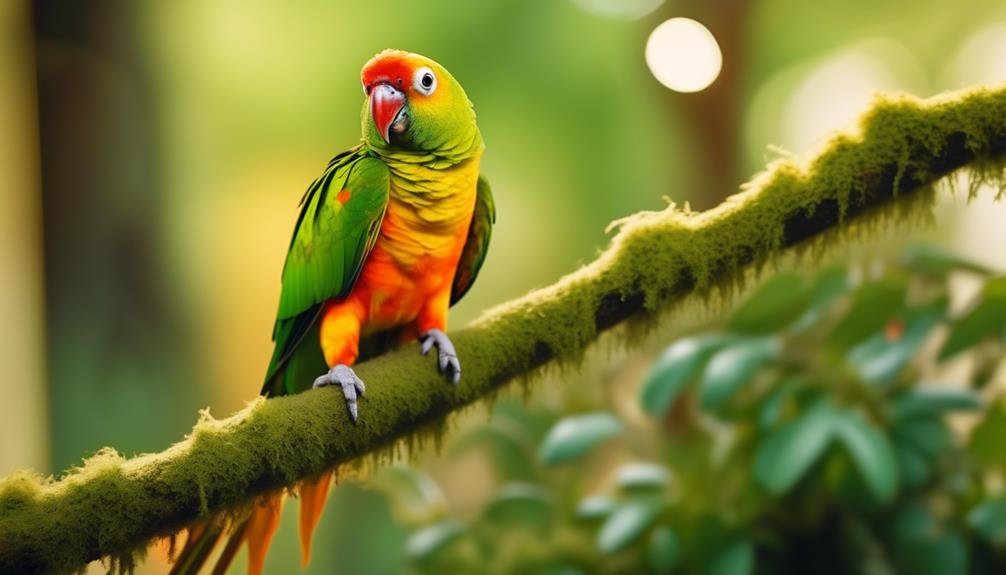
As you stroll through the park, enjoying the gentle breeze and the warm rays of the sun, a flash of vibrant orange catches your eye. Curiosity piqued, you pause to catch a glimpse of the source.
And there it is, perched on a branch, a charming and chatty creature – the enigmatic Orange Fronted Conure. But what makes this petite parrot so special? What secrets lie hidden behind its colorful feathers and melodic chatter?
Join us as we embark on a journey to uncover the captivating world of the Orange Fronted Conure, and prepare to be amazed by the wonders that await.
Key Takeaways
- Orange Fronted Conures are the smallest breed in the Aratinga Conures family, measuring approximately 9 inches in size.
- They have an impressive lifespan of around 30 years, making them a long-term companion for bird lovers.
- With their vibrant green feathers and orange details, Orange Fronted Conures are visually striking and beautiful birds.
- These conures are known for their social and affectionate personality, forming deep bonds with their chosen family members.
Size and Lifespan
Orange Fronted Conures are known for their compact size and impressive lifespan. These charming birds measure approximately 9 inches in size, making them the smallest breed in the Aratinga Conures family. Despite their small stature, they’ve a remarkable lifespan of around 30 years, which is quite impressive for a parrot.
With their vibrant green feathers and orange details, they’re a sight to behold. But it’s not just their appearance that makes them unique. Orange Fronted Conures are also known for their vocal abilities. While they’re considered the quietest breed in the conure species, they can still produce moderately loud natural calls and even learn to talk and mimic words.
Their size and lifespan, combined with their charming personality, make Orange Fronted Conures a delightful addition to any home.
Colors and Sounds
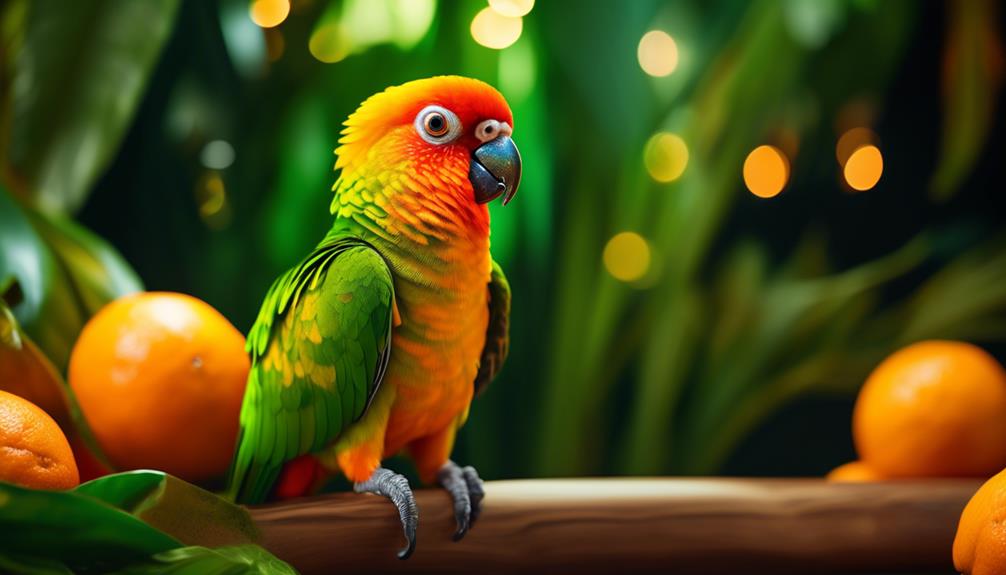
With their vibrant plumage and unique vocal abilities, Orange Fronted Conures captivate both the eyes and ears of their owners. These charming birds are primarily green in color, with orange details that add a pop of brightness to their appearance. When it comes to sounds, Orange Fronted Conures are known for their range of vocalizations. They have quiet natural calls, mimicry skills that allow them to imitate other sounds, and delightful chirping. Their vocal abilities make them engaging and entertaining companions. To give you a better understanding, here’s a table summarizing the colors and sounds of Orange Fronted Conures:
| Colors | Sounds |
|---|---|
| Primarily green with orange details | Quiet natural calls |
| Mimicry of other sounds | |
| Delightful chirping |
With their stunning colors and delightful sounds, Orange Fronted Conures are sure to bring joy to any bird lover.
Interaction and Personality
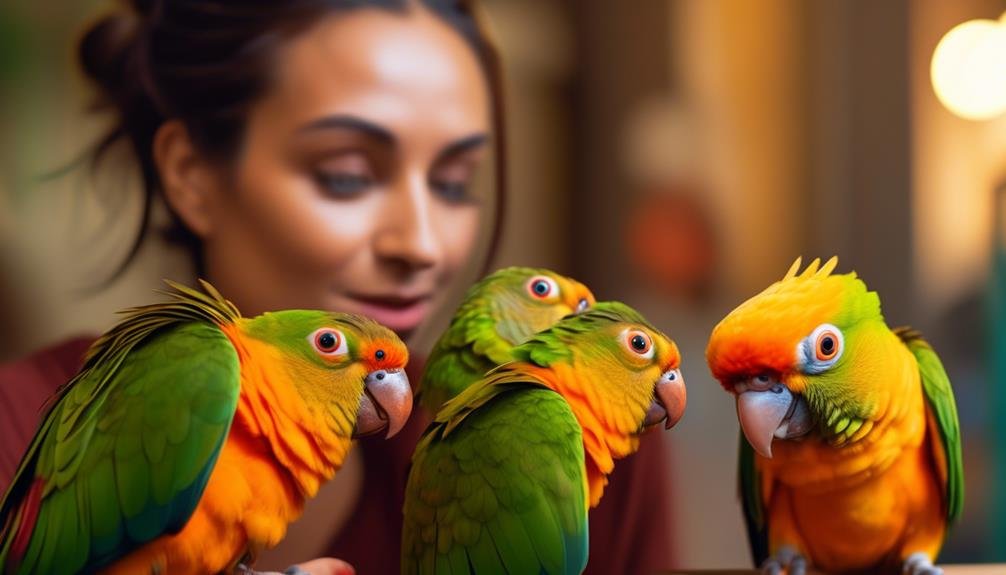
When interacting with an Orange Fronted Conure, you’ll be delighted by their social and affectionate personality. They’re known for their charming and chatty nature, making them a joy to be around. Here are three delightful traits that you can expect when interacting with these lovely birds:
- Playfulness: Orange Fronted Conures are fun-loving and playful companions. They enjoy engaging in interactive games and love exploring their environment. Their energetic nature will keep you entertained for hours.
- Friendliness: These conures are incredibly friendly and enjoy being around people. They thrive on social interaction and will eagerly seek out your attention. Their friendly demeanor makes them excellent companions for both individuals and families.
- Affection: Orange Fronted Conures are known for their affectionate nature. They form deep bonds with their chosen family members and enjoy cuddling and being close. Their loving nature will make you feel cherished and loved.
Interacting with an Orange Fronted Conure is a rewarding experience filled with joy and affection.
Comparable Breeds
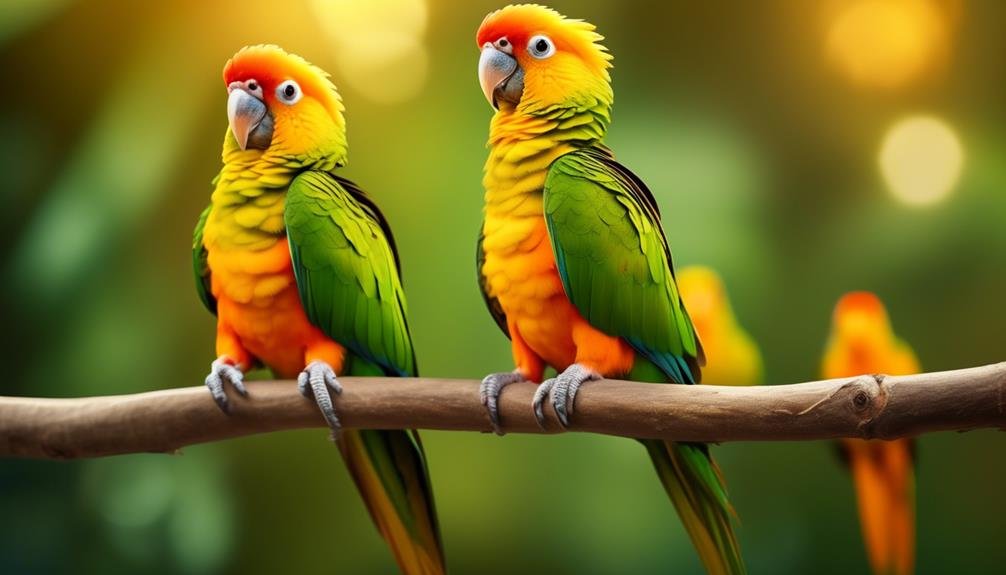
If you’re interested in exploring other breeds similar to the Orange Fronted Conure, you may want to consider the Mitred Conure or the Sun Conure.
The Mitred Conure shares many similarities with the Orange Fronted Conure in terms of size, lifespan, and colors. It’s also social, affectionate, and playful, making it a great companion bird.
The Sun Conure, on the other hand, is known for its vibrant colors and energetic personality. Like the Orange Fronted Conure, it’s social, friendly, and can form deep bonds with its family members.
Both the Mitred Conure and the Sun Conure are popular choices for bird lovers looking for a breed that exhibits similar characteristics to the charming and chatty Orange Fronted Conure.
Native Region and Habitat
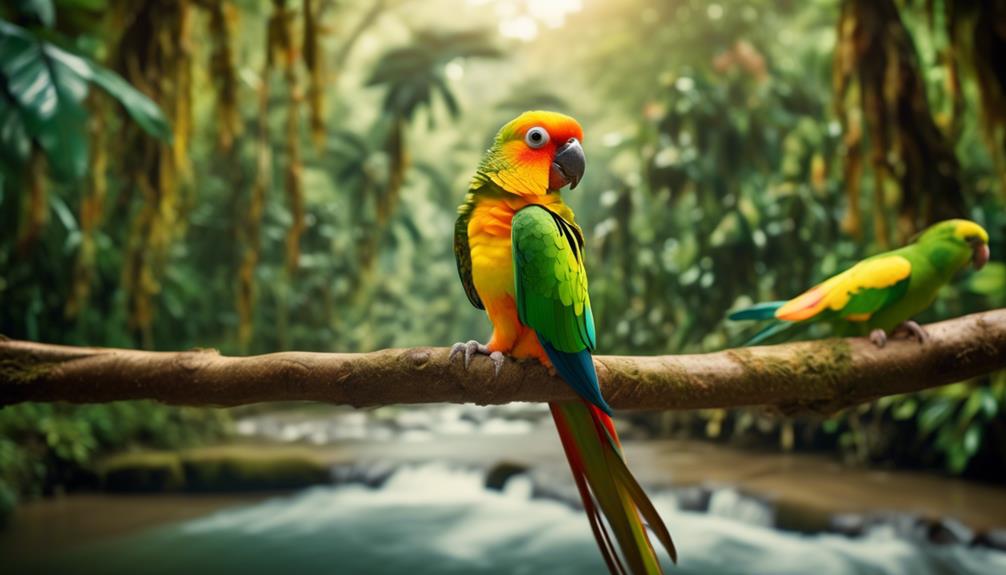
Orange Fronted Conures are native to the Central American Pacific coastline. They thrive in light, open areas, arid lowlands, and tropical woodlands. They’ve adapted well to these diverse habitats and can be found in regions such as Mexico, Guatemala, and Honduras.
These charismatic birds exhibit nesting behavior by laying their eggs in termite mounds high up in trees. This provides them with protection and a safe place to raise their young. Their ability to adapt to different environments has contributed to their widespread presence in their native region.
Orange Fronted Conures have found a way to coexist with humans in urban areas. This makes them a delightful sight for birdwatchers and nature enthusiasts.
Nesting Behavior
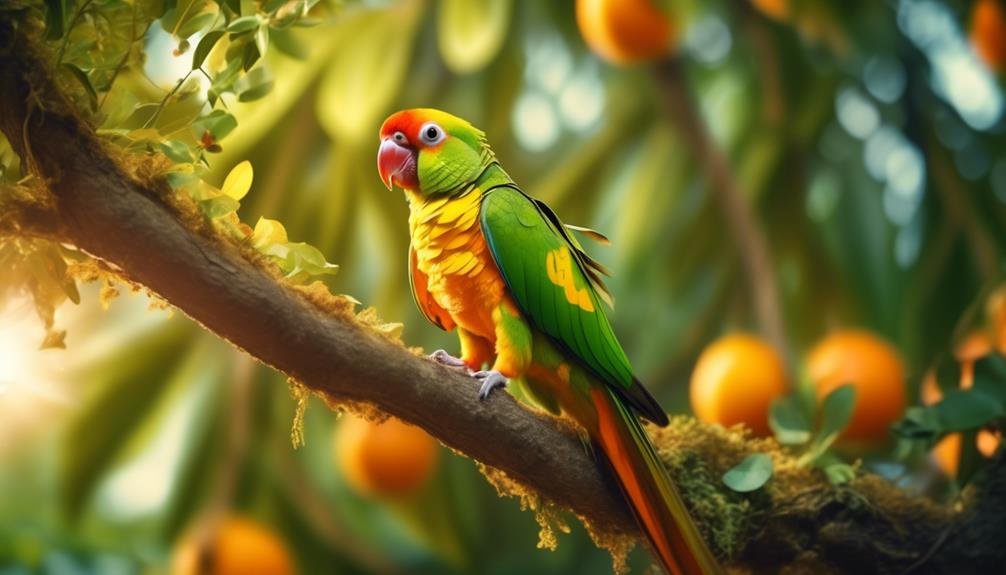
To understand the nesting behavior of Orange Fronted Conures, you need to observe their choice of nesting sites and their unique approach to raising their young.
These conures prefer to lay their eggs in termite mounds high up in trees. This choice of nesting site provides them with protection and security for their eggs and young chicks. The conures carefully select a suitable mound and excavate a cavity inside it to create a cozy nest.
Once the eggs are laid, both the male and female take turns incubating them and caring for the hatchlings. They’re attentive parents, feeding their chicks a diet of fruits, seeds, and insects.
The nesting period typically lasts for several weeks until the chicks are ready to fledge and leave the nest.
This nesting behavior showcases the resourcefulness and adaptability of these charming and chatty birds.
Overall Description
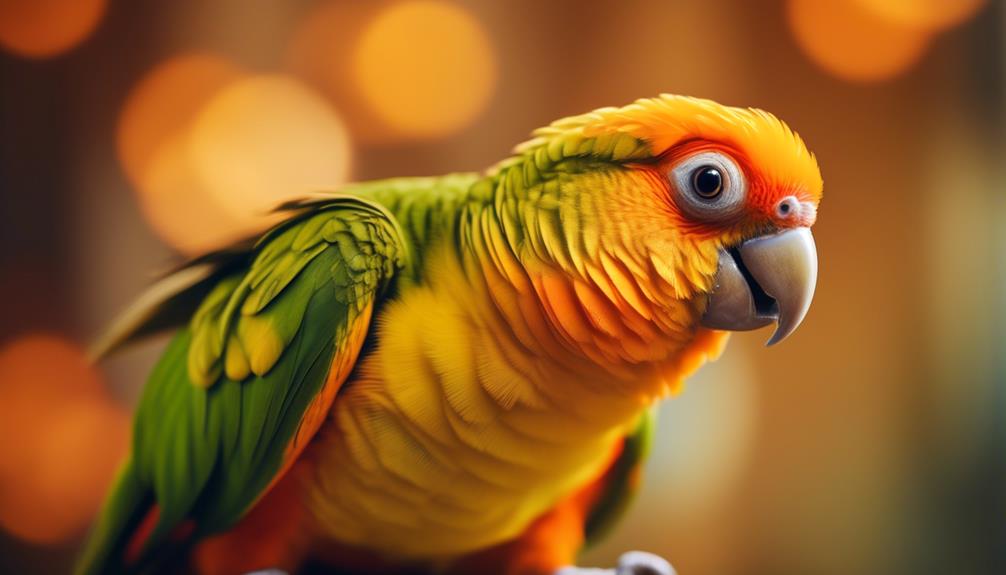
With their slender, tapered tail and distinct color changes in females, the Orange Fronted Conures are a visually striking breed in the Aratinga Conures family. These charming birds have a few key characteristics that make them stand out:
- Slender tail: The Orange Fronted Conures have a unique tail shape that adds to their overall elegance and gracefulness.
- Color changes in females: While both males and females have predominantly green feathers, the females undergo color changes as they mature, developing vibrant orange patches on their head and chest.
- Visually striking appearance: With their slender tail and vibrant orange accents, Orange Fronted Conures are truly eye-catching and beautiful birds.
Speech and Vocal Abilities
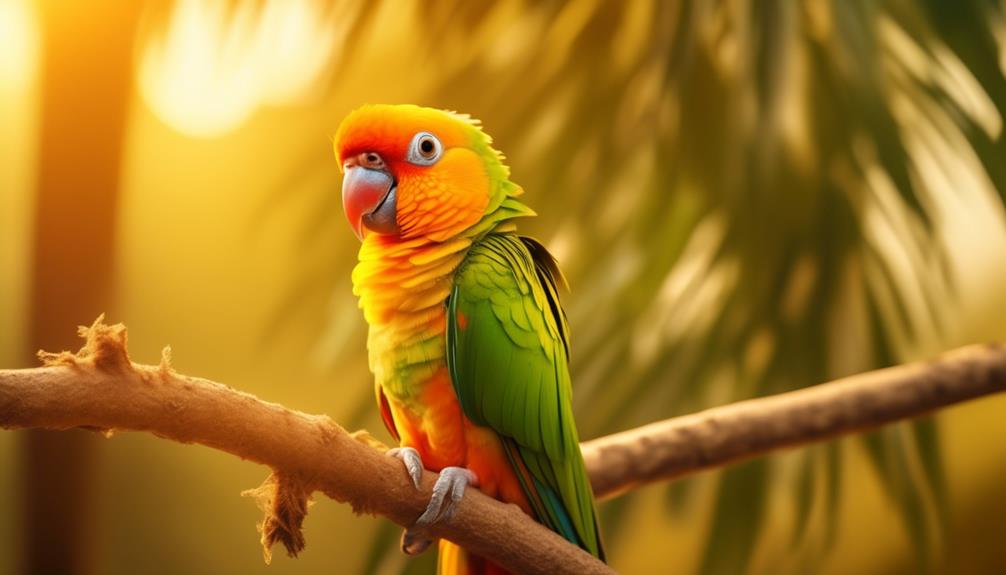
As we shift our focus to the speech and vocal abilities of these charming birds, it’s fascinating to explore how Orange Fronted Conures communicate with their unique sounds and vocalizations.
Orange Fronted Conures are considered the quietest breed in the conure species, but they still have moderately loud natural calls. They can also learn to talk and mimic words, making them capable of limited speech.
Their vocal repertoire includes quiet natural calls, mimicry, and chirping. While they may not be as talkative as some other parrot species, their ability to mimic sounds and learn words adds to their charm.
It’s important to note that individual birds may vary in their speech abilities, with some being more proficient than others. Nonetheless, their chatty nature and unique sounds make them delightful companions.
Frequently Asked Questions
What Is the Average Clutch Size for Orange Fronted Conures?
The average clutch size for Orange Fronted Conures is typically around 3 to 4 eggs. They exhibit nesting behavior by laying their eggs in termite mounds high up in trees.
How Do Orange Fronted Conures Communicate With Each Other in the Wild?
Orange Fronted Conures communicate with each other in the wild through a variety of vocal sounds, including natural calls, mimicry, and chirping. They use these sounds to establish territory, locate mates, and warn of danger.
Are Orange Fronted Conures Capable of Learning Tricks and Commands?
Yes, Orange Fronted Conures are capable of learning tricks and commands. They are intelligent and eager to please, making them great candidates for training. With patience and consistency, you can teach them a variety of fun and impressive tricks.
How Do Orange Fronted Conures Adapt to Different Climates?
Orange Fronted Conures are adaptable to different climates. They naturally inhabit light, open areas, arid lowlands, and tropical woodlands. Their ability to thrive in various habitats makes them well-suited to adjusting to changes in temperature and environmental conditions.
Are There Any Specific Challenges in Caring for Orange Fronted Conures as Pets?
Caring for Orange Fronted Conures as pets can have specific challenges. They require social interaction, mental stimulation, and a balanced diet. Regular vet check-ups and proper housing are important.
Are Orange Fronted Conures and Maroon Bellied Conures Similar in Personality and Behavior?
Are Orange Fronted Conures and Maroon Bellied Conures similar in personality and behavior? While both charming maroon bellied conures and orange-fronted conures are lively and sociable birds, they may exhibit slight variations in behavior. Maroon bellied conures tend to be more vocal and outgoing, while orange-fronted conures are known for their mischievous and playful nature. Nonetheless, both make delightful pets for bird enthusiasts.
Conclusion
In conclusion, the Orange Fronted Conure is a captivating and talkative bird that brings joy and color to any bird lover’s home. With their vibrant green feathers and striking orange details, they’re a sight to behold.
These social and affectionate birds have the potential to form deep bonds with their chosen family members and can live up to 30 years.
Their vocal abilities, from natural calls to mimicry, will keep you entertained for hours.
The Orange Fronted Conure truly is a charming and chatty companion.

